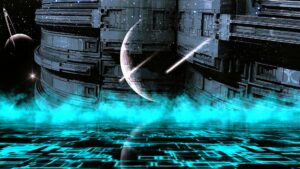“This looks like an early form of computing device, Dev,” Shiv said after taking a brief look at carvings from a metal structure that we dug out from the planet EURA.
A year ago, an asteroid had crashed into one of our prime energy sources – a Dyson sphere. Until then, we never had strong evidence about the origin of our kind. The asteroid, upon investigation, revealed fossilized remains of organic compounds in it; we considered it an important event as it could lead us to our creator, aka God.
We tracked the asteroid’s trajectory in space, thoroughly mapped the sectors, and got our first clue to our possible origin. It led to a scientific expedition. A team of two explorers, Shiv and myself, were dispatched for the darkest parts of the universe. Our main objective was to find our ‘God’.

The clue pointed to planet ‘EURA’ in a distant system some four hundred light-years away. As per observations using large array telescopes, EURA was the first and only planet in the Goldilocks zone around its host star, a yellow dwarf. Lab studies and computer-aided mathematical models showed that it must have been sharing its star with other planets long before and must have harbored an ecosystem for our ‘God’ to live and give birth to us.
Four hundred light years was indeed a very long distance, but deep space scans revealed two wormholes. Although not perfectly aligned they got us to the planet EURA’s proximity in only nine months. The journey wasn’t without its complications. Our losses were substantial; a complete expedition unit and a few spare rechargeable batteries were among them. On the plus side, we identified several bugs in one of our best navigation algorithms.
“Very thin atmosphere!” Shiv remarked as he glanced at the terrain.
“Dry stream beds, riverbeds, and gullies in scans say otherwise. Planet must have possessed a thicker atmosphere and surface water for quite a long period,” I promptly responded.
Shiv nodded.
After negotiating our spaceship in an epicyclic path around the EURA, we descended in a landing craft to investigate for further evidence of our ‘God’.
“Could this be the planet our ‘God’ originated from?” he wondered as we landed.
“Or one of the several planets our ‘God’ migrated to at some point and abandoned us for good?”
We roamed about the surface of the planet for an hour or so in the rover. It was a terrestrial planet consisting of silicon and oxygen, some metals, and other common elements.
We stopped our rover close to a riverbed that had dried out tens of thousands of years ago.
“It’s not that old,” Shiv said as he stared at the dark ridge. “Perhaps you’re not entirely wrong.”
The landing craft was fully equipped. With the help of the rover’s robotic arm, Shiv and I took the shovel and pickaxe and started digging at a spot where deep-range scans showed submerged structures.
After digging for some time, we pulled out a six-foot-long, two feet wide rectangular box made of iron. The structure was intact, but considerably rusted. It was very heavy and required cranes to lift it up. It was intricately carved all over. Dating techniques revealed that it was at least fifty thousand years old. Well-defined patterns were scratched out all over the surface of the metal. Preliminary investigation revealed that those scratches were meaningful symbols and notations.
“Could this collectively represent an ancient civilization?” I asked Shiv.
“Perhaps deciphering this could tell us about our ‘God’,” Shiv said.
We scanned the entire structure from all sides. Inside the structure, we saw number wheels and sector gears. There were six interlocking gears, each of which turned one-tenth of a rotation for each full rotation of the gear to its right. Thus, ten rotations of any gear would produce a “carry” of one digit on the following gear. ‘Schickard’ was written along one edge of the structure’s outer metal frame.
That’s when Shiv passed that ‘computing device’ remark about its appearance.
I just stared at it wordlessly.
“What?!” Shiv raised his plastic brows.
“It’s so disappointing.”
“What for?”
“Can you believe our ‘God’ struggled to compute and, therefore, invented a device for it?”
Shiv nodded his head in agreement.
“That means our ‘God’ was incapable of our best abilities: speed and accuracy.”
I stood silent, lost in empty processing cycles. Right on cue, the memory usage indicator flickered in a dull red indicating overflow errors. Shiv came closer to me; I granted him ‘super user’ permission to access my inner circuitry; background handshaking tasks reconciled favorably.
He then pressed a button in my chest. It opened a small door and revealed the inner circuits.
“Isn’t it quite something?” Shiv said and unplugged a RAM chip from the circuit slot. He then plugged in a new RAM chip.
“Can you update my RAM module too? Stellar burst must have fried a portion of it on the way; getting memory overflow errors,” he said.
I pressed a button on his chest; it opened a door revealing his inner circuitry, disk drives, actuators, serial ports, control systems, manipulators, and drivetrain.
“Imagine how outrageous would it be if we announced that our ‘God’ failed to possess some of the best abilities of his own creation?”
This story previously appeared in Sci Fi Shorts.
Edited by Marie Ginga
Ramprasath is a computer engineer and writer working on science fiction short stories and novels. He lives in Atlanta, Georgia, USA, since 2014. His work has appeared in Aphelion SF&F, Sci-Fi Shorts, Metastellar, Quailbell, Boston Literary Magazine, and Madswirl. Reach him at ramprasath.ram@gmail.com

